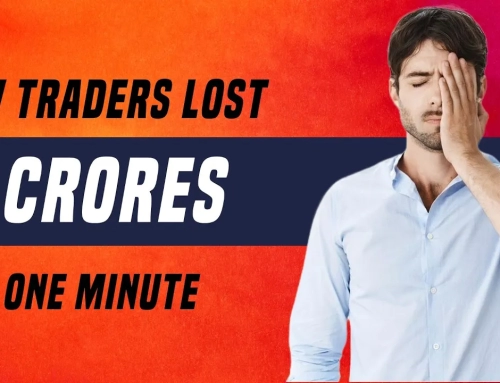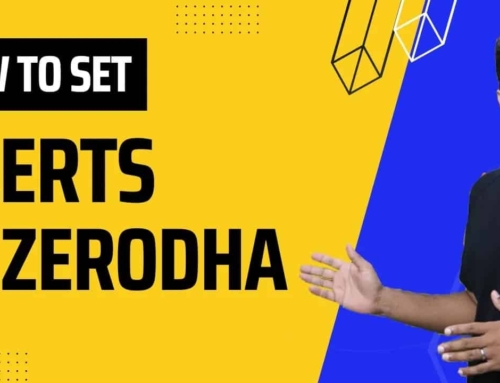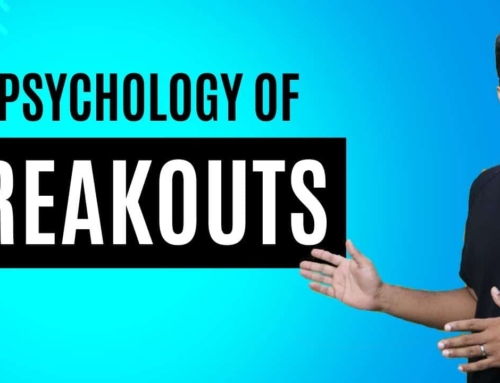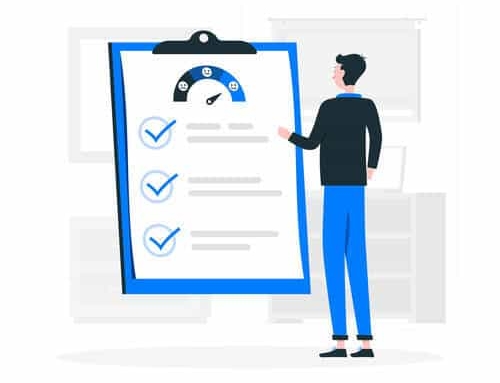Can We Trade Without Price Action?
My journey as a trader started as a price action trader. For a very long time, I just used to look at the price action, the key levels, trends and momentum and used to operate based on the price action. I used to trade in stocks first, then from stocks, I moved to bank nifty and for a very long time, I just used to trade Bank nifty in futures.
At that time, I did not focus on options, but a paradigm shift happened when I started using options. What I realized was that when you combine that understanding of price action with the power of options, then you get up deadly combination.
So there are traders out there who are just trading based on price action and then there are traders who are purely trading based on their knowledge of options. I think it’s time that people understand that these things need not be mutually exclusive. It’s not that if you are a price action trader, you should not be trading in options or if you’re an options trader, you should not be looking at price action. These things can be combined.
I saw the benefit of this approach and that’s what I started doing and now things have gone up to the extent that I don’t touch futures at all. I’m primarily trading in options nowadays and depending on the price action, movement, volatility and trend, either I’m buying or selling options.
Price action still happens to be the foundation of me taking a trade, but there is one thing which always bothered me and that was there are people out there who, without having any understanding of price action, support and resistance are trading in options and then they are still making money. I always felt puzzled that I come from a background of price action. It’s easy for me to spot support, resistance, trend and also easy for me to deploy options, but for someone to trade without an understanding of a price section made me wonder.
What I am doing right now is I’m experimenting a little bit where let’s say, for example, I assume that I have no understanding of price action and no bias, either on the long side or on the short side. So can someone with no understanding of price action and only a pure understanding of options be profitable on an intraday basis, swing or position trading basis?
That is the one thought experiment that I’m doing right now and this is a result of that. I’ve been doing this on and off for the last month, but now I’m getting a little bit more active on this.
My approach has not been finalized yet, and I’m hoping that at least by the end of this month, I should be done with that so that for all those of you who are attending the workshop, I can give you the crux of all that I’ve been experimenting with. What I will do is in this video is at least talk about the broad approach of what I’m working on.
The approach works on the principle of equilibrium price at any point in time. Let’s say for example today if you take a look at the market, it was weak in the first half, and then it recovered in the second half. I took trades on the short side and on the long side. In a normal circumstance, I would have taken a directional trade and hence when the market was coming down, I would have taken up a short trade by either selling a call option or buying a put option.
When the market recovered in the second half, I would have bought a call option or sold a put option. That is how my typical combination of price action with options work, but the experiment that I’m doing right now assumes that I don’t know anything about price action.
Now, how does a trader who has no understanding of price action would deal on a day like this? The way I do it is these are the set of trades that I took in the morning. So I traded nifty and I traded using this approach where I had an equilibrium price. So what is an equilibrium price?
Equilibrium price means that at this price, a hundred points here or a hundred points here. So I am set in this way. In this particular case, 17,800 put options and a combination of this with a call option mean something which is working in the opposite direction. So this is working in opposite direction, the combination and the weightage of these two pairs in these two positions should be in such a way that if the market moves a hundred points up or a hundred points down, I should not be seeing a significant change in my P&L and that is the number one principle of equilibrium price
The market has to make a significant move about this hundred points so that I have to make some kind of adjustment. So, I’m not looking at the charts, support, resistance or trend. I’m just focused on my equilibrium price and when the equilibrium price starts to suggest that the equilibrium is shifting in the market, then I go for adjustments. What I did was in the first half, I took some trades on the Nifty and this was an order entry issue and so I unnecessarily incurred a loss here when I was sitting on a profit of about 20,000 rupees there.
However, then I took some trades in the second half on bank nifty from around one o’clock and I’m planning to carry these positions, hopefully up until expiry, or at least until Wednesday. I followed the same principle here.
So I have two opposite positions. As you can see, one is this 39,200 put option, and I have a 40,000 call option and these two are hedges to get the margin benefits and just by adjusting the equilibrium price, what I’m trying to do is that I’m constantly shifting the equilibrium price with the market movements and at any point, I’m always having two opposite positions.
This is the crux and I don’t have too much detail right now because I have to figure out a lot of adjustment details, but what is surprising is that without an understanding of price action, also trades can workout.
The reason for this is very simple. The reason is number one, time decay which is always working in my favour. Let’s say, for example, if the market closes anywhere in between 39200 and 40000 in the next two days, I will make 1400 multiplied by 140 and I will also make 2000 multiplied by 150. I will make money from both these sides and it will come to about 6 lakh rupees. That is also the first reason why people trade options.
It is because there is a time decay that you can benefit from and the second is in the fall of Volatility. If you see the way India VIX was rising in the morning and then VIX fell. So by taking the advantage of a fall in volatility or increase in volatility, depending on which direction it is moving, and time decay, all I have to do is keep myself not too far from the equilibrium price.
That is the core principle on which I am working right now. Hopefully I will have some models by the end of this month when I would have seen different cycles and timeframes. So that is it, guys. I’m a big fan of options and I truly believe that they are the weapon that every trader should have and should know how to use this weapon.
The other misconception that a lot of people have is you need a lot of capital to be able to trade options and that is not true. I will address this maybe in a separate video and this is something that I thought I would share with you guys today.
It was a very interesting trade with no directional bias whatsoever. I saw the charts once in a while, but I did not trade based on them. I was looking at my equilibrium price and I was adjusting and that’s all I was doing.
I’m hoping that this trade gives me a bigger profit in the next couple of days. I hope that you guys will at least get some ideas from what I’m doing right now, and hopefully apply that in your real-life trading.
Can We Trade Without Price Action?
My journey as a trader started as a price action trader. For a very long time, I just used to look at the price action, the key levels, trends and momentum and used to operate based on the price action. I used to trade in stocks first, then from stocks, I moved to bank nifty and for a very long time, I just used to trade Bank nifty in futures.
At that time, I did not focus on options, but a paradigm shift happened when I started using options. What I realized was that when you combine that understanding of price action with the power of options, then you get up deadly combination.
So there are traders out there who are just trading based on price action and then there are traders who are purely trading based on their knowledge of options. I think it’s time that people understand that these things need not be mutually exclusive. It’s not that if you are a price action trader, you should not be trading in options or if you’re an options trader, you should not be looking at price action. These things can be combined.
I saw the benefit of this approach and that’s what I started doing and now things have gone up to the extent that I don’t touch futures at all. I’m primarily trading in options nowadays and depending on the price action, movement, volatility and trend, either I’m buying or selling options.
Price action still happens to be the foundation of me taking a trade, but there is one thing which always bothered me and that was there are people out there who, without having any understanding of price action, support and resistance are trading in options and then they are still making money. I always felt puzzled that I come from a background of price action. It’s easy for me to spot support, resistance, trend and also easy for me to deploy options, but for someone to trade without an understanding of a price section made me wonder.
What I am doing right now is I’m experimenting a little bit where let’s say, for example, I assume that I have no understanding of price action and no bias, either on the long side or on the short side. So can someone with no understanding of price action and only a pure understanding of options be profitable on an intraday basis, swing or position trading basis?
That is the one thought experiment that I’m doing right now and this is a result of that. I’ve been doing this on and off for the last month, but now I’m getting a little bit more active on this.
My approach has not been finalized yet, and I’m hoping that at least by the end of this month, I should be done with that so that for all those of you who are attending the workshop, I can give you the crux of all that I’ve been experimenting with. What I will do is in this video is at least talk about the broad approach of what I’m working on.
The approach works on the principle of equilibrium price at any point in time. Let’s say for example today if you take a look at the market, it was weak in the first half, and then it recovered in the second half. I took trades on the short side and on the long side. In a normal circumstance, I would have taken a directional trade and hence when the market was coming down, I would have taken up a short trade by either selling a call option or buying a put option.
When the market recovered in the second half, I would have bought a call option or sold a put option. That is how my typical combination of price action with options work, but the experiment that I’m doing right now assumes that I don’t know anything about price action.
Now, how does a trader who has no understanding of price action would deal on a day like this? The way I do it is these are the set of trades that I took in the morning. So I traded nifty and I traded using this approach where I had an equilibrium price. So what is an equilibrium price?
Equilibrium price means that at this price, a hundred points here or a hundred points here. So I am set in this way. In this particular case, 17,800 put options and a combination of this with a call option mean something which is working in the opposite direction. So this is working in opposite direction, the combination and the weightage of these two pairs in these two positions should be in such a way that if the market moves a hundred points up or a hundred points down, I should not be seeing a significant change in my P&L and that is the number one principle of equilibrium price
The market has to make a significant move about this hundred points so that I have to make some kind of adjustment. So, I’m not looking at the charts, support, resistance or trend. I’m just focused on my equilibrium price and when the equilibrium price starts to suggest that the equilibrium is shifting in the market, then I go for adjustments. What I did was in the first half, I took some trades on the Nifty and this was an order entry issue and so I unnecessarily incurred a loss here when I was sitting on a profit of about 20,000 rupees there.
However, then I took some trades in the second half on bank nifty from around one o’clock and I’m planning to carry these positions, hopefully up until expiry, or at least until Wednesday. I followed the same principle here.
So I have two opposite positions. As you can see, one is this 39,200 put option, and I have a 40,000 call option and these two are hedges to get the margin benefits and just by adjusting the equilibrium price, what I’m trying to do is that I’m constantly shifting the equilibrium price with the market movements and at any point, I’m always having two opposite positions.
This is the crux and I don’t have too much detail right now because I have to figure out a lot of adjustment details, but what is surprising is that without an understanding of price action, also trades can workout.
The reason for this is very simple. The reason is number one, time decay which is always working in my favour. Let’s say, for example, if the market closes anywhere in between 39200 and 40000 in the next two days, I will make 1400 multiplied by 140 and I will also make 2000 multiplied by 150. I will make money from both these sides and it will come to about 6 lakh rupees. That is also the first reason why people trade options.
It is because there is a time decay that you can benefit from and the second is in the fall of Volatility. If you see the way India VIX was rising in the morning and then VIX fell. So by taking the advantage of a fall in volatility or increase in volatility, depending on which direction it is moving, and time decay, all I have to do is keep myself not too far from the equilibrium price.
That is the core principle on which I am working right now. Hopefully I will have some models by the end of this month when I would have seen different cycles and timeframes. So that is it, guys. I’m a big fan of options and I truly believe that they are the weapon that every trader should have and should know how to use this weapon.
The other misconception that a lot of people have is you need a lot of capital to be able to trade options and that is not true. I will address this maybe in a separate video and this is something that I thought I would share with you guys today.
It was a very interesting trade with no directional bias whatsoever. I saw the charts once in a while, but I did not trade based on them. I was looking at my equilibrium price and I was adjusting and that’s all I was doing.
I’m hoping that this trade gives me a bigger profit in the next couple of days. I hope that you guys will at least get some ideas from what I’m doing right now, and hopefully apply that in your real-life trading.



![What is Virtual Contract Note [Zerodha]](https://www.vrdnation.com/wp-content/uploads/2023/10/maxresdefault-virtual-note-500x383.jpg)



Leave A Comment